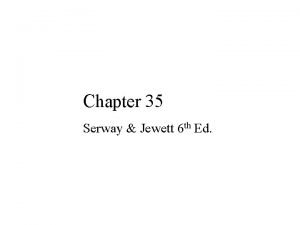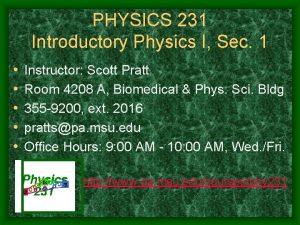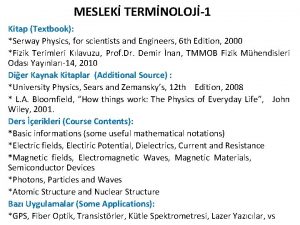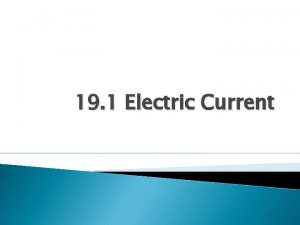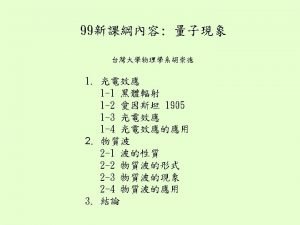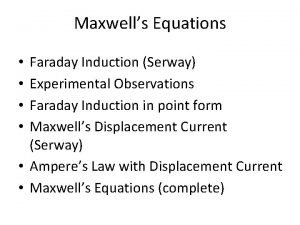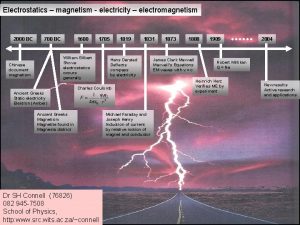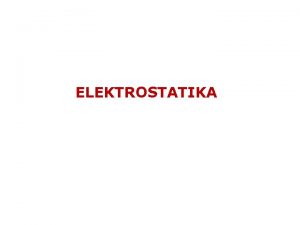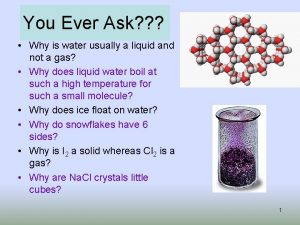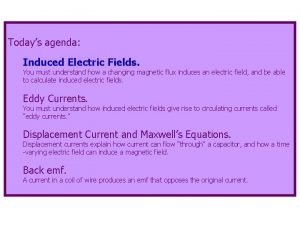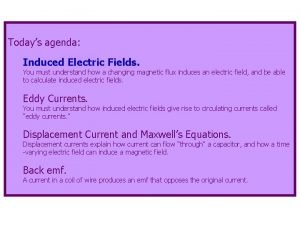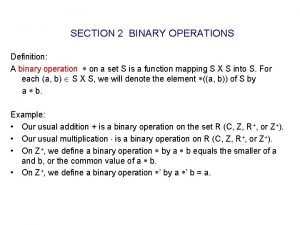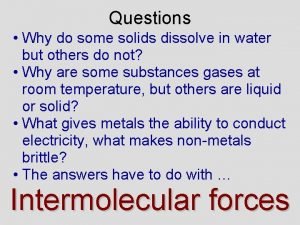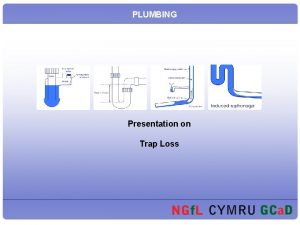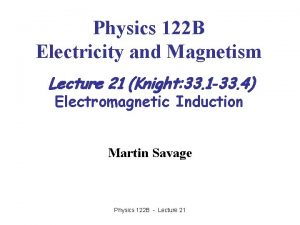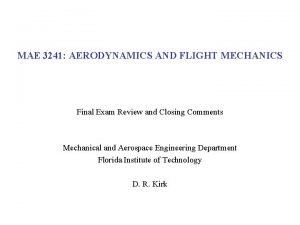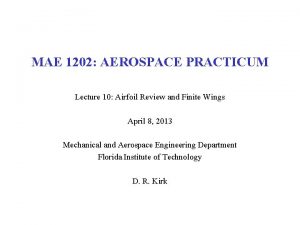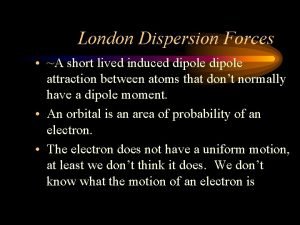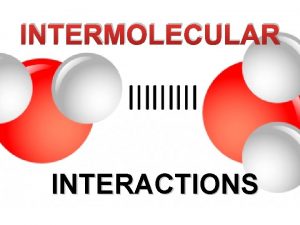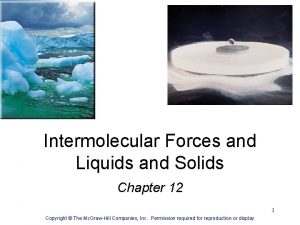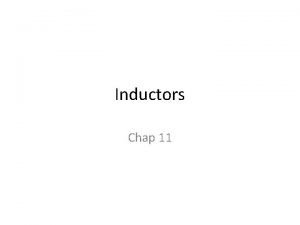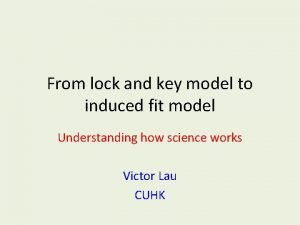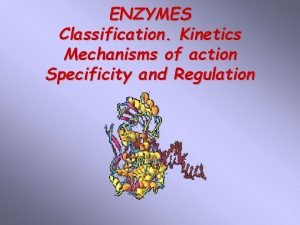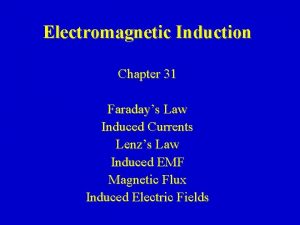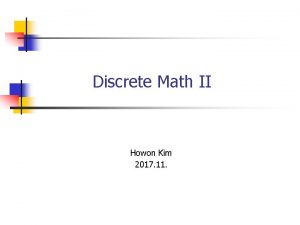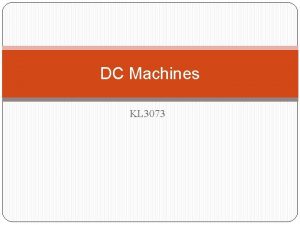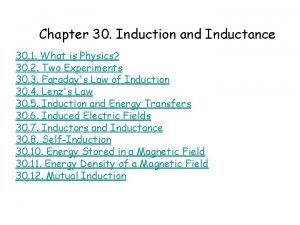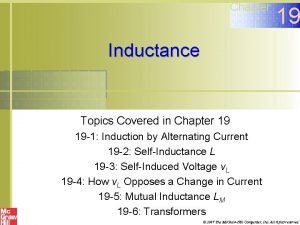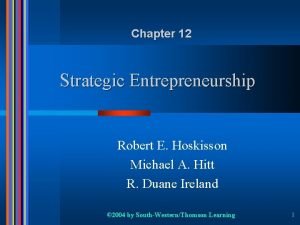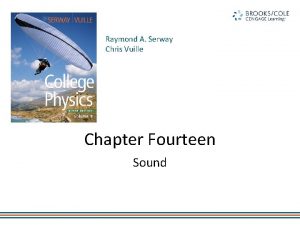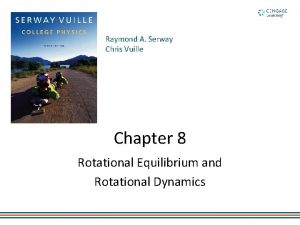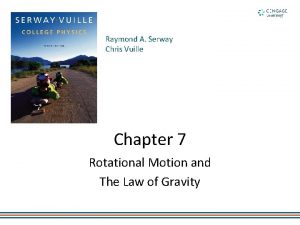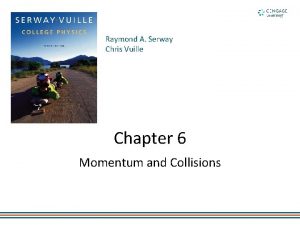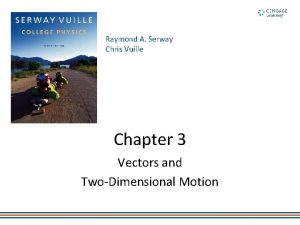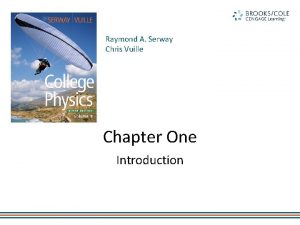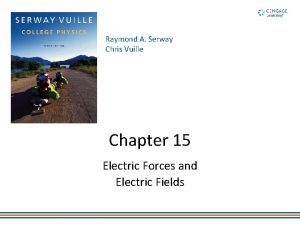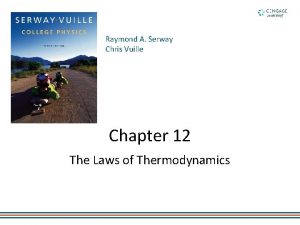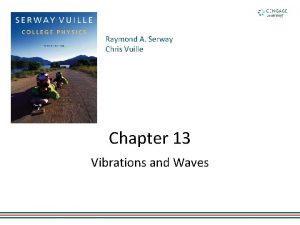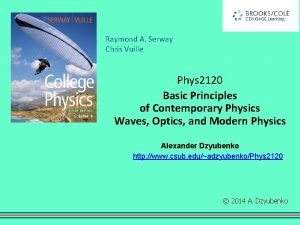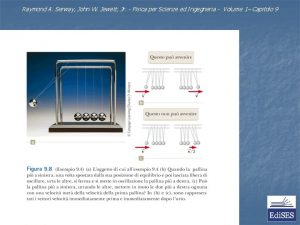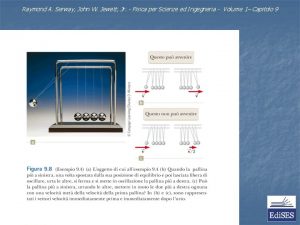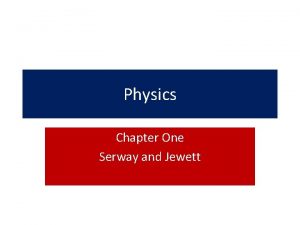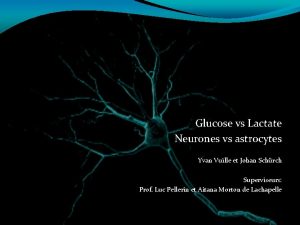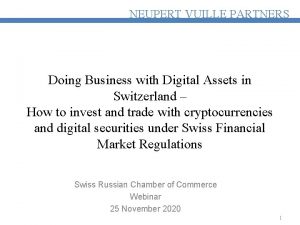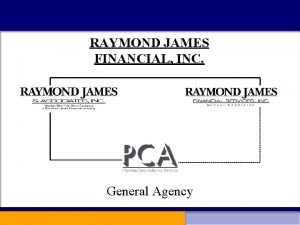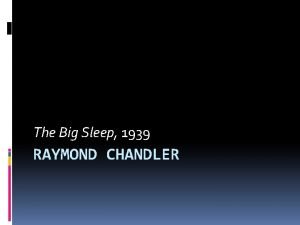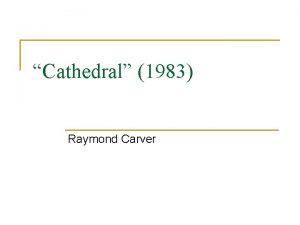Raymond A Serway Chris Vuille Chapter 20 Induced









































- Slides: 41

Raymond A. Serway Chris Vuille Chapter 20 Induced Voltages and Inductance

Connections Between Electricity and Magnetism • 1819 – Hans Christian Oersted discovered an electric current exerts a force on a magnetic compass. – First evidence of a link between electricity and magnetism • 1831 – Faraday and Henry showed a changing magnetic field could induce an electric current in a circuit. – Led to Faraday’s Law Introduction

Michael Faraday • 1791 – 1867 • Great experimental scientist • Invented electric motor, generator and transformers • Discovered electromagnetic induction • Discovered laws of electrolysis Section 20. 1

Faraday’s Experiment – Set Up • A current can be produced by a changing magnetic field. – First shown in an experiment by Michael Faraday • A primary coil is connected to a battery. • A secondary coil is connected to an ammeter. Section 20. 1

Faraday’s Experiment • There is no battery in the secondary circuit. • When the switch is closed, the ammeter reads a current and then returns to zero. • When the switch is opened, the ammeter reads a current in the opposite direction and then returns to zero. • When there is a steady current in the primary circuit, the ammeter reads zero. Section 20. 1

Faraday’s Conclusions • An electrical current is produced by a changing magnetic field. • The secondary circuit acts as if a source of emf were connected to it for a short time. • It is customary to say that an induced emf is produced in the secondary circuit by the changing magnetic field. Section 20. 1

Magnetic Flux • The emf is actually induced by a change in the quantity called the magnetic flux rather than simply by a change in the magnetic field. • Magnetic flux is defined in a manner similar to that of electrical flux. • Magnetic flux is proportional to both the strength of the magnetic field passing through the plane of a loop of wire and the area of the loop. Section 20. 1

Magnetic Flux, 2 • You are given a loop of wire. • The wire is in a uniform magnetic field. • The loop has an area A. • The flux is defined as – ΦB = B A cos θ • θ is the angle between B and the normal to the plan • SI unit: weber (Wb) – Wb = T. m 2 Section 20. 1

Magnetic Flux, 3 • When the field is perpendicular to the plane of the loop, as in a, θ = 0 and ΦB = ΦB, max = BA • When the field is parallel to the plane of the loop, as in b, θ = 90° and ΦB = 0 – The flux can be negative, for example if θ = 180° Section 20. 1

Magnetic Flux, Final • The flux can be visualized with respect to magnetic field lines. – The value of the magnetic flux is proportional to the total number of lines passing through the loop. • When the area is perpendicular to the lines, the maximum number of lines pass through the area and the flux is a maximum. • When the area is parallel to the lines, no lines pass through the area and the flux is 0. Section 20. 1

Electromagnetic Induction – An Experiment • When a magnet moves toward a loop of wire, the ammeter shows the presence of a current (a). • When the magnet is held stationary, there is no current (b). • When the magnet moves away from the loop, the ammeter shows a current in the opposite direction (c ). • If the loop is moved instead of the magnet, a current is also detected. Section 20. 2

Electromagnetic Induction – Results of the Experiment • A current is set up in the circuit as long as there is relative motion between the magnet and the loop. – The same experimental results are found whether the loop moves or the magnet moves. • The current is called an induced current because is it produced by an induced emf. Section 20. 2

Faraday’s Law and Electromagnetic Induction • The instantaneous emf induced in a circuit equals the negative time rate of change of magnetic flux through the circuit. • If a circuit contains N tightly wound loops and the flux changes by ΔΦB during a time interval Δt, the average emf induced is given by Faraday’s Law: Section 20. 2

Faraday’s Law and Lenz’ Law • The change in the flux, ΔΦB, can be produced by a change in B, A or θ – Since ΦB = B A cos θ • The negative sign in Faraday’s Law is included to indicate the polarity of the induced emf, which is found by Lenz’ Law. – The current caused by the induced emf travels in the direction that creates a magnetic field with flux opposing the change in the original flux through the circuit. Section 20. 2

Lenz’ Law – Example • The magnetic field, , becomes smaller with time. – This reduces the flux. • The induced current will produce an induced field, , in the same direction as the original field. Section 20. 2

Applications of Faraday’s Law – Ground Fault Interrupters • The ground fault interrupter (GFI) is a safety device that protects against electrical shock. – Wire 1 leads from the wall outlet to the appliance. – Wire 2 leads from the appliance back to the wall outlet. – The iron ring confines the magnetic field, which is generally 0. – If a leakage occurs, the field is no longer 0 and the induced voltage triggers a circuit breaker shutting off the current. Section 20. 2

Applications of Faraday’s Law – Electric Guitar • A vibrating string induces an emf in a coil. • A permanent magnet inside the coil magnetizes a portion of the string nearest the coil. • As the string vibrates at some frequency, its magnetized segment produces a changing flux through the pickup coil. • The changing flux produces an induced emf that is fed to an amplifier. Section 20. 2

Applications of Faraday’s Law – Apnea Monitor • The coil of wire attached to the chest carries an alternating current. • An induced emf produced by the varying field passes through a pick up coil. • When breathing stops, the pattern of induced voltages stabilizes and external monitors sound an alert. Section 20. 2

Application of Faraday’s Law – Motional emf • A straight conductor of length ℓ moves perpendicularly with constant velocity through a uniform field. • The electrons in the conductor experience a magnetic force. – F=qv. B • The electrons tend to move to the lower end of the conductor. Section 20. 3

Motional emf • As the negative charges accumulate at the base, a net positive charge exists at the upper end of the conductor. • As a result of this charge separation, an electric field is produced in the conductor. • Charges build up at the ends of the conductor until the downward magnetic force is balanced by the upward electric force. • There is a potential difference between the upper and lower ends of the conductor. Section 20. 3

Motional emf, Cont. • The potential difference between the ends of the conductor can be found by – ΔV = E l = B ℓ v – The upper end is at a higher potential than the lower end • A potential difference is maintained across the conductor as long as there is motion through the field. – If the motion is reversed, the polarity of the potential difference is also reversed. Section 20. 3

Motional emf in a Circuit • Assume the moving bar has zero resistance. • As the bar is pulled to the right with a given velocity under the influence of an applied force, the free charges experience a magnetic force along the length of the bar. • This force sets up an induced current because the charges are free to move in the closed path. Section 20. 3

Motional emf in a Circuit, Cont. • The changing magnetic flux through the loop and the corresponding induced emf in the bar result from the change in area of the loop. • The induced, motional, emf acts like a battery in the circuit. Section 20. 3

Generators • Alternating Current (AC) generator – Converts mechanical energy to electrical energy – Consists of a wire loop rotated by some external means – There a variety of sources that can supply the energy to rotate the loop. • These may include falling water, heat by burning coal to produce steam Section 20. 4

AC Generators, Cont. • Basic operation of the generator – As the loop rotates, the magnetic flux through it changes with time. – This induces an emf and a current in the external circuit. – The ends of the loop are connected to slip rings that rotate with the loop. – Connections to the external circuit are made by stationary brushes in contact with the slip rings. Section 20. 4

AC Generators, Final • The emf generated by the rotating loop can be found by ε =2 B ℓ v =2 B ℓ sin θ • If the loop rotates with a constant angular speed, ω, and N turns ε = N B A ω sin ω t • ε = εmax when loop is parallel to the field • ε = 0 when the loop is perpendicular to the field Section 20. 4

AC Generators – Detail of Rotating Loop • The magnetic force on the charges in the wires AB and CD is perpendicular to the length of the wires. • An emf is generated in wires BC and AD. • The emf produced in each of these wires is ε= B ℓ v = B ℓ sin θ Section 20. 4

DC Generators • Components are essentially the same as that of an ac generator • The major difference is the contacts to the rotating loop are made by a split ring, or commutator Section 20. 4

DC Generators, Cont. • The output voltage always has the same polarity. • The current is a pulsing current. • To produce a steady current, many loops and commutators around the axis of rotation are used. – The multiple outputs are superimposed and the output is almost free of fluctuations. Section 20. 4

Motors • Motors are devices that convert electrical energy into mechanical energy. – A motor is a generator run in reverse. • A motor can perform useful mechanical work when a shaft connected to its rotating coil is attached to some external device. Section 20. 4

Motors and Back emf • The phrase back emf is used for an emf that tends to reduce the applied current. • When a motor is turned on, there is no back emf initially. • The current is very large because it is limited only by the resistance of the coil. Section 20. 4

Motors and Back emf, Cont. • As the coil begins to rotate, the induced back emf opposes the applied voltage. • The current in the coil is reduced. • The power requirements for starting a motor and for running it under heavy loads are greater than those for running the motor under average loads. Section 20. 4

Self-inductance • Self-inductance occurs when the changing flux through a circuit arises from the circuit itself. – As the current increases, the magnetic flux through a loop due to this current also increases. – The increasing flux induces an emf that opposes the change in magnetic flux. – As the magnitude of the current increases, the rate of increase lessens and the induced emf decreases. – This decreasing emf results in a gradual increase of the current. Section 20. 5

Self-inductance, Cont. • The self-induced emf must be proportional to the time rate of change of the current. – L is a proportionality constant called the inductance of the device. – The negative sign indicates that a changing current induces an emf in opposition to that change. Section 20. 5

Self-inductance, Final • The inductance of a coil depends on geometric factors. • The SI unit of self-inductance is the Henry – 1 H = 1 (V · s) / A • You can determine an expression for L Section 20. 5

Joseph Henry • 1797 – 1878 • First director of the Smithsonian • First president of the Academy of Natural Science • First to produce an electric current with a magnetic field • Improved the design of the electro-magnet and constructed a motor • Discovered self-inductance Section 20. 5

Inductor in a Circuit • Inductance can be interpreted as a measure of opposition to the rate of change in the current. – Remember resistance R is a measure of opposition to the current. • As a circuit is completed, the current begins to increase, but the inductor produces an emf that opposes the increasing current. – Therefore, the current doesn’t change from 0 to its maximum instantaneously. Section 20. 6

RL Circuit • When the current reaches its maximum, the rate of change and the back emf are zero. • The time constant, , for an RL circuit is the time required for the current in the circuit to reach 63. 2% of its final value. Section 20. 6

RL Circuit, Graph • The current increases toward the maximum value of ε/R Section 20. 6

RL Circuit, Cont. • The time constant depends on R and L. • The current at any time can be found by Section 20. 6

Energy Stored in a Magnetic Field • The emf induced by an inductor prevents a battery from establishing an instantaneous current in a circuit. • The battery has to do work to produce a current. – This work can be thought of as energy stored by the inductor in its magnetic field. – PEL = ½ L I 2 Section 20. 7
 How do london dispersion forces work
How do london dispersion forces work Serway
Serway Serway
Serway Serway textbook
Serway textbook Serway
Serway Serway
Serway Faraday's law
Faraday's law Serway
Serway Serway
Serway London dispersion forces induced dipole
London dispersion forces induced dipole Viral induced wheeze vs asthma
Viral induced wheeze vs asthma Induced electric field
Induced electric field Field
Field Drug induced sle
Drug induced sle Definition of binary operation
Definition of binary operation Induced dipole
Induced dipole Poss level
Poss level Induced siphonage
Induced siphonage Induced current formula
Induced current formula Acetylcholinesterase
Acetylcholinesterase Aerodynamics exam
Aerodynamics exam Induced drag formula
Induced drag formula Dispersion forces vs dipole dipole
Dispersion forces vs dipole dipole Chem ufl
Chem ufl Vander waals force
Vander waals force Ion induced dipole examples
Ion induced dipole examples Instantaneous dipole
Instantaneous dipole Inductance
Inductance Alcohol-induced pain in hodgkin lymphoma
Alcohol-induced pain in hodgkin lymphoma Mechanism of action of bivalirudin
Mechanism of action of bivalirudin Induced fit model vs lock and key
Induced fit model vs lock and key Induced fit hypothesis
Induced fit hypothesis What is faraday's law in physics
What is faraday's law in physics Induced fit hypothesis
Induced fit hypothesis Drug induced thrombocytopenia
Drug induced thrombocytopenia Induced subgraph
Induced subgraph Induced voltage formula
Induced voltage formula Conductor moving in a magnetic field
Conductor moving in a magnetic field Induced voltage formula
Induced voltage formula Induced strategic behavior
Induced strategic behavior What is induced angle of attack
What is induced angle of attack Dipole induced dipole forces examples
Dipole induced dipole forces examples

